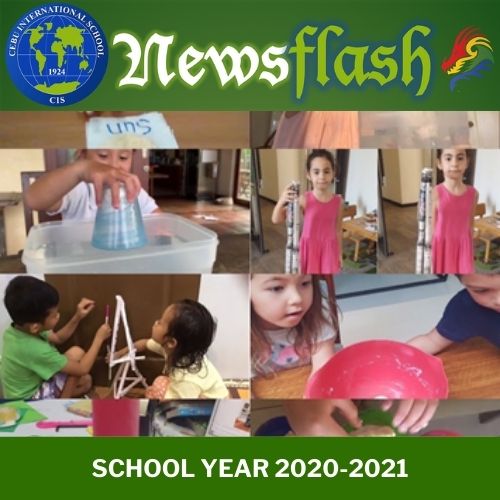
Admin News
by Dr. Gwyn Underwood, CIS Superintendent
Congratulations to the CIS Community members who helped prepare for, 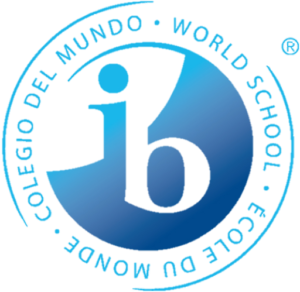 and who participated in, our IB Middle Years Programm (MYP) verification visit this past week. Based on the exit interview, I can report that it went very well, but we do need to wait for the IB Regional Office to review our application before they can make a final determination on our status. I want to thank our faculty for all of their efforts implementing the MYP over the past couple of years, with special recognition for Mr. Jonathan Denton, our Assistant Principal-MYP, who has done a truly exemplary job coordinating the implementation. We will know the final outcome within 1-2 months.
and who participated in, our IB Middle Years Programm (MYP) verification visit this past week. Based on the exit interview, I can report that it went very well, but we do need to wait for the IB Regional Office to review our application before they can make a final determination on our status. I want to thank our faculty for all of their efforts implementing the MYP over the past couple of years, with special recognition for Mr. Jonathan Denton, our Assistant Principal-MYP, who has done a truly exemplary job coordinating the implementation. We will know the final outcome within 1-2 months.
Upcoming events of note:
- April 23: Half day of school; CIS EduForum in the afternoon (this is biannual event where CIS faculty provide professional learning sessions to local educators from around the Philippines!)
- April 23: Last day of classes for G12
- April 28: Parent Coffee Morning (9-10am)
- May 1: Labour Day Holiday
Please refer to the CIS Event calendar (https://cis.edu.ph/school-calendar/) for the complete calendar of the school events.
Elementary News
by Ms. Maureen Juanson, PYP Coordinator
This past week, our PYP learners engaged in consolidating their learning and understanding of their fifth unit of inquiry. It’s great to see students continuing to show enthusiasm and eagerness to learn, discover, and explore the concepts that they are working on in their respective classes at this point of the school year.
The Grade 5s have been focused on their PYP exhibition journey and are in the process of researching to find answers to the questions related to the issues and topics that they are greatly passionate about. As they organize, collaborate, and gather data, they are able to demonstrate the ATL skills that they have been developing throughout the years in the PYP. We are looking forward to witnessing their PYPx live presentations in May.
As we come closer to the end of the school year, our PYP teachers began collecting data to help us identify and celebrate the progress and growth that each student has made this school year. It is important that we are able to collect this information in order to continuously provide necessary support to individual students as we move into our final units of inquiry next week and prepare them for the next grade level.
Early Years (EY2/3-AS)
After Easter break, the Early Years began exploring our new unit, ” Where We Are in Place and Time” by unpacking the words Place and Time. Many of us shared our understanding that a Place is somewhere we want to go, and somewhere we build our house. Our young learners also explained what a family is. We all think that a family has a mom, dad, and children. We had a sharing of the story, Applesauce Day written by Lisa J. Amstutz. The Early Years shared some of the unique and special activities they do together as a family. We learned that Traditions are things that we do with our families that are usually passed on from our grandparents to our parents and then to us.
The Grade 2s and 3s together with the Early Years have started with our Buddy Reading classes and some have started with their end-of-the year assessments. Next week, we will continue to learn more about our families and share more about family traditions.

Kinder and Grade 1 Tamaraws – How The World Works
The Kinder and Grade 1 Tamaraws have been inquiring and exploring the unit How the World Works. It started with the word matter, and then the students put on their thinking hats and began their journey of curiosity. They have discovered the different properties of matter around them, how they look and feel like. At the same time they also learned that most of the words that define matter are called describing words or adjectives.
As they continued exploring the unit, the students engaged in different experiments starting with Ice Cube Meltdown. Students were asked to put ice cubes under different conditions and share their hypothesis. Different results were gathered and presented in their Science journal. They carried on with other experiments such as Paper Tower Challenge, Changing properties of Playdough and Air Experiment.
Just before we went on spring break, the Kinder and Grade 1 students created something from materials that they found at home. The challenge was to choose two materials and create something new out of it. Some of them were really amazing and it was good to know that students chose the materials for their creations based on the properties the materials had.

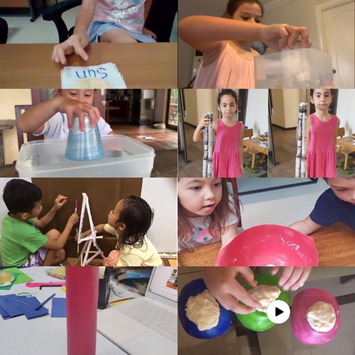
Middle and High School News
by Mr. Dale Wood, Middle & High School Principal
After a welcomed break following one of the longest continuous stretches of the school year, last Tuesday our students and teachers returned, refreshed and rejuvenated, to their virtual classrooms. As we carry on through these final weeks of the school year, we are committed to investing our best efforts to helping our students finish the year successfully.
This is the home stretch for us as we look forward to just seven more weeks until the end of the school year. This week we will be sharing how selected classes in the Science and Language Acquisition (which includes EAL) departments are engaging our students both cognitively and in other important dimensions as we seek to meet their holistic needs.

The MYP Grade 9 Science students recently learned about reactions including photosynthesis and cellular respiration. They investigated the rate of reaction involving yeast, were able to conduct a lab virtually and write a full lab report. Students also analyzed graphs to find the half-life, the time it takes for a sample of an unstable radioactive substance to decay and the properties of nuclear reactions including alpha, beta, and gamma radiation. One student was inquisitive during this time by asking about how to solve for half-life using calculations.
Students also made a wonderful Health Department pamphlet educating employees in the workplace about the dangers of radiation which they presented to their class. According to one recent article, they found out that there is evidence of no harmful radiation from cell phones, which has been a topic of rigorous debate for the past two decades. Some students shared that they do not use their cell phones too much or they use the speaker phone option as a healthy habit. They are currently learning more about The Particle Theory and Energy including Heat, Heat Transfer, and Waves in Physics.
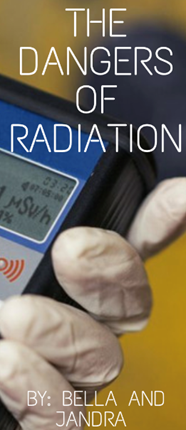



 MYP Grade 10 Science (Semester Two) Students had the opportunity to explore mechanics concepts by designing their own experiment involving motion. They carried out physical exercises such as climbing a step or stair(s) and carrying out push ups to collect data involving work and time to calculate their own power in joules per second (watts), a concept which they are analyzing.
MYP Grade 10 Science (Semester Two) Students had the opportunity to explore mechanics concepts by designing their own experiment involving motion. They carried out physical exercises such as climbing a step or stair(s) and carrying out push ups to collect data involving work and time to calculate their own power in joules per second (watts), a concept which they are analyzing.
DP Physics students (Year 1) have been learning about Wave Phenomena with the content differentiated for the Standard and Higher students during this unit. For Year 2 students, proud moments were experienced as they prepared and gave presentations/tips about their personal research process and main findings from their Internal Assessment. They also said, “Good bye,” to their final reports of their scientific research as the reports were sent off to the IB Organization for external grading. Year 1 students will say, “Hello!” to these same explorations soon. They are at the stage of brainstorming their ideas for their own experiment which they will research, design, and carry out using experimental procedures to investigate their findings based on their original scientific question. The work of the Year 2 students will serve as student exemplars for the Year 1 students.
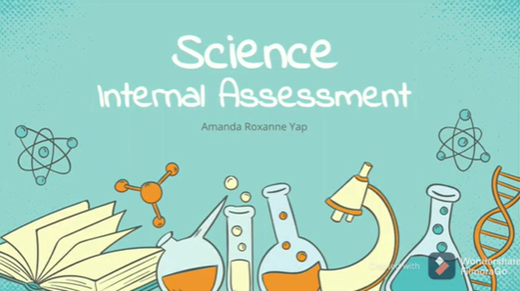
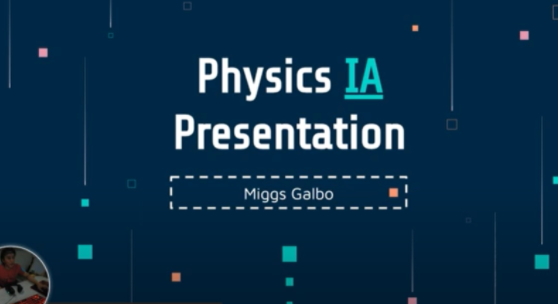

Science 8
Interaction session with Architect Junie Rubia
The unit entitled, ‘Eco-house’, focuses on the environment as students explore environmentally-friendly applications of the properties of matter and the changes these undergo. This unit challenges the students to use their understanding and skills to be able to design an eco-house which incorporates the theme of sustainability in the design and use of materials.
To enrich the students’ learnings about the unit, the class invited Architect Junie Rubia to share about his current practice in house design and construction. Mr. Rubia is a practitioner in the architectural field and is also a professor in the Architecture Department of University of San Carlos. Sustainable design in houses and buildings is one of the key elements in his work. As a result, his sharing and interaction with the Grade 8 students was very educational.

These are some of our students’ reflections after the interaction session.
What are your realizations from the sharing of Archt. Junie Rubia?
That a green house does not mean it has lots of plants, but it is something that is sustainable. – Caleb
Bamboo is actually very durable. Though you can’t use them all the time because you have to design the building you’re creating with bamboo to go along the growth of the bamboo. – Aaryan
I learned that when developing an eco-house you need to have a way to let airflow in, and to ventilate the toxic materials out of the house. I also learned that eco-houses reduce energy usage by 20%. – Elijah
Describe the environment-friendly materials which can be used in designing eco-houses?
Some of the “green” or environmentally friendly materials that can be utilized for planning eco-houses are reused steel, bamboo, concrete, wood, glass, bricks timber, compost, soil, straws, fiber, etc. and all of these “green” materials are environmentally friendly and are very useful for designing eco houses. – Miguel
The following are sample outputs of the students.
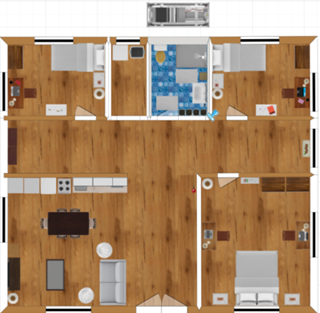 Design by Fiana
Design by Fiana
Sustainable practices in the design:
– Use of many large windows
– Installation of water cistern that stores rainwater
– Solar panels on the roof (not seen in the layout)
(www.roomstyler.com)

Design by Gab
(2nd floor) Sustainable practices in the design:
– Use of many large windows
– Installation of water cistern that stores rainwater (not seen in the layout)
– Solar panels on the roof
(www.roomstyler.com)
Chemistry 10
After learning about the structure of atoms and how these affect the properties and nature of chemical bonding of different substances, the students are now extending their understanding to the nature and applications of varied chemical reactions in unit II, ‘Chemical reactions around us’.
The unit commences with its contextualization. One of the activities involved a group game using the goosechase app. In teams, the students accomplished 10 missions which allow them to identify different products (home-based) involving chemical reactions. These were some of their accomplished tasks.
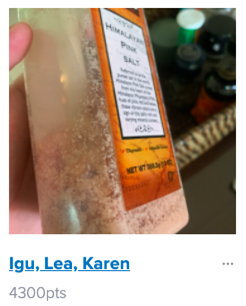
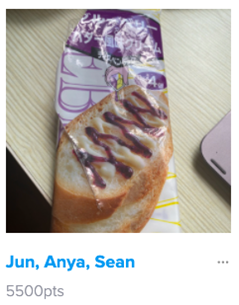
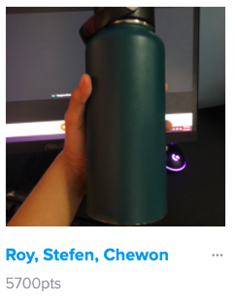
Furthermore, one of the learning objectives of the current unit is to increase the awareness of the students regarding the impact of varied chemical reactions in their daily lives. Using the examples in their respective homes, the students developed a short presentation to showcase common reactions with their corresponding effects.
Screenshots of students’ works:



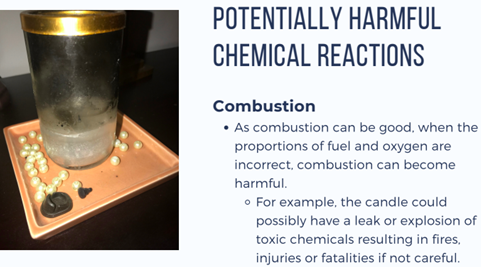
Chemistry 11
Simple ‘home chemistry’ for kinetics
The use of baking soda and vinegar is very common for science demonstrations and experiments because the materials are readily available and safe to use. In the absence of our “official” school science laboratory, the class used this simple reaction to collect data at home and process the data to investigate the effect of concentration on the rate of the chemical reaction (a kinetics study).
The following are some of the experimental set-ups.
 by Jenny
by Jenny
Pour in the vinegar to each of the glasses, then the baking soda, and as soon as the baking soda touches the surface of the vinegar, start the timer. As soon as the reaction slowing is observed, stop the stopwatch and record the time on the table. This image just shows all the three glasses together, however when conducting the experiment, each trial was conducted separately, individually for more accuracy.
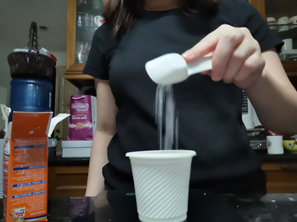 by Jodi
by Jodi
Pouring baking soda into the small container to be measured on the digital weighing scale
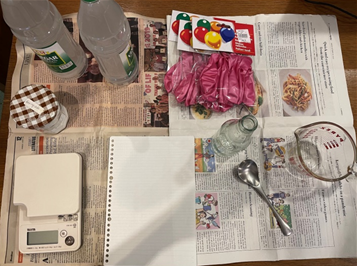 by Daigo
by Daigo
This image shows the setup of the experiment which includes the materials as well as the apparatus that were used.
The gathered data were analyzed particularly at the instantaneous rates of the simple chemical reaction. This involved the use of graphing techniques which demonstrates a very relevant integration of math concepts in a science course.

With the necessary adjustments in the manner of conducting scientific investigations during online learning, the students were still able to meet the course expectations. They were able to identify both random and systematic errors and worked their way through minimizing these even in a home set-up. They used their critical thinking and took risks as they designed their own experiments.
News from our Language Acquisition classes
Mandarin AB
Mandarin ab initio Grade 11 students are continuing to develop their language skills and expand their vocabulary during remote learning. As we discussed food and drinks, students presented their knowledge about this topic by cooking many different Chinese-style foods at home, for example, steamed fish, soy sauce fried rice, dumplings, noodles, and Sichuan pork. Students were able to enhance their cooking skills and make the perfect connection with the target culture through Chinese Food. Recently we also discussed community and public facilities.
Mandarin ab initio Grade 12 has successfully completed their IA and Mock Exams. Congratulations to them for their hard work and great progress in this course. I am grateful to see how much they have grown under such difficult circumstances. As we begin to wrap up the course and also allow students to be reflective on their own learning experience, we also reflect on our learning experiences over the past 2 years. Grade 12 students wrote a detailed summary about their learning strategies and useful resources. They also included their feedback about personal learning and the teacher’s instruction.
Spanish Ab Initio
Grade 11 students have worked on developing their writing skills. The new format they have been working on is Message- Nota and students have used this platform to explore some topics related to house chores, homes, and stores. The following is an example of their written texts:
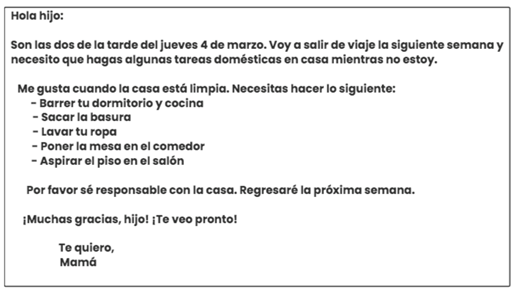
Grade 12 students have been working hard to prepare for their Spanish ab initio Internal Assessment.
Among some of the general questions in the IA, students were able to compare and contrast their culture and the Spanish language culture. These are insights from grade 12 students comparing and contrasting some aspects of both cultures.
Similarities and differences:
- Una similitud de Filipinas con la mayoría de los países hispano hablantes especialmente en el centro de América es que suelen tener muchos días soleados y clima tropical por lo que la ropa en ambos países es parecida.
A similarity between the Philippines and most Spanish- speaking countries, especially in Central America, is the sunny days and tropical climate, so the clothes in both countries are similar.
- Una similitud de Filipinas con la mayoría de los países hispano hablantes es que las familias van a la iglesia para escuchar misa los domingos.
A similarity between the Philippines and most Spanish speaking countries is that families go to church to hear mass on Sundays.
- En la cultura filipina, coreana y japonesa comer arroz en las tres comidas del día es muy común.
In Philippine, Korean and Japanese cultures eating rice for all three meals of the day is common.
- En la cultura hispana, principalmente en España el arroz es uno de los ingredientes principales para hacer paella pero no forma parte de las tres comidas del día como en los países asiáticos.
In the Hispanic culture, mainly in Spain, rice is one of the main ingredients to make paella. Unlike in Asian countries, it is not eaten for all three meals of the day.
Spotlight: Grade 12 Mandarin B
After successfully completing the final round of their IBDP journey, the Grade 12 students in Mandarin B are ready to impart their knowledge of the language to a younger generation. Recently, the class has focused on refreshing the basics of Mandarin in order to teach it effectively to grade 6 and 7 students. The goal is to develop a solid foundation and cultivate their fluency in the language through an online setting.
They have created video modules on topics such as: “How to Introduce Yourself,” “Countries,” and “Fruits and Vegetables.” These will serve as a fun way for beginners to get acquainted with the language, all while establishing a good foundation for future topics, such as “Transportation” and “Health”.
The students will also have a chance to host a teaching session with the younger students next week, where students’ knowledge may be enhanced through interactive activities.
The next goal of the class is to enrich the HSK vocabulary of our grade 8 and 9 students. This will help the incoming IBDP Mandarin students build their confidence in their language, as well as improve their reading comprehension and speaking abilities. After all, expanding one’s vocabulary is one of the most important aspects of learning a language; in Mandarin, it is important to know the right words to say in a sentence in order to communicate effectively.
An Emphasis on Reflective Communication
IBDP Mandarin will not only test your fluency in the language, but it will also broaden your perspective of the world as you learn more about the Chinese culture. Every aspect of the language includes a rich historical background and highlights enduring values within the Chinese culture; as such, one can expand their views of the world and learn the traditional ideals of filial piety and harmony, among many others.
Moreover, you can experience and analyze how the Chinese culture has evolved over time. One example is the celebration of Chinese New Year: while the traditional practice of giving red envelopes still persists, the development of modern technology has allowed family members to send each other these envelopes via online platforms such as WeChat. You can also discuss the different subcultures in Chinese society, such as fast food culture. Sounds exciting, doesn’t it?
All in all, the Mandarin class allows students to gain a deeper understanding of Chinese culture, thus allowing them to become more compassionate and reflective communicators.
My journey of learning Mandarin was filled with difficulties, since the language was confusing and difficult to learn. Although it has been a difficult journey, I still enjoyed learning the language through IB Mandarin. IB Mandarin not only gave me more knowledge on the language, but also on the interesting culture of China. Learning the culture while studying the language gave me new perspectives on diversity. — Joshua
In IB Mandarin I learned the Chinese language and culture. Learning Chinese took a lot of patience and practice, but the class helped me overcome the fear of speaking a new language and gain confidence. — Louise
Learning a language that over 1.3 billion people speak is no easy task, but definitely a worthwhile experience. Learning Mandarin not only provides you access to fluent communication but also allows you to connect to China at a deeper level. — Dana
IB Mandarin has been a great experience for me. I did not only learn the Chinese language, but I also learned Chinese culture. Learning a new language has allowed me to broaden my perspective and embrace diversity all around the world. — James
Chinese… is a fun challenge. It’s definitely not for the faint of heart, and even if you’re already familiar with the language, the subject still poses challenges for you in terms of your reading, writing, speaking, and listening ability. It’s a tough subject—but the good news is that it makes you even tougher! A culture is ten times better when you experience it versus when you simply hear about it… so if I may propose one challenge: Take a Mandarin class! In school or online, it doesn’t really matter. My only hope is that you may find the beauty in Chinese the way I did through my Mandarin class. — Venise
English as an Additional Language
Try to imagine seeking to grasp the fundamentals of a language while also learning within that language in all of your other courses. This is the unique challenge faced by our EAL students. Add to this the complexity of using online platforms such as Google Classroom.Whether it was easy or difficult, it could be considerably more challenging to learn to use in a language you are still beginning to understand. Words like “resubmission” or “optional” could be new vocabulary words for English Language Learners in the remote learning environment. Connecting with others can be incredibly helpful to motivate and encourage students to participate and be more confident in class.
Here are a few ways we can help our EAL students connect to each other and support their learning:
- Home connection
Teacher communication with parents and vice versa about the students’ English language learning has been found by research to be effective in establishing a home-school connection. Translating feedback into the home language of families can really drive important points home. This was shown to help ELL students practice and use the language even after school hours, which is an important step to help them master the language.
- Classmates and connecting
Many students feel isolated, especially during remote learning, due to the physical distance from their peers. Some of our new CIS students have never even met their classmates face-to-face. Encouraging small group interactions can increase their chances of reaching out and talking to their classmates. Guided peer activities provide beginning students the opportunity to extend their current skills and knowledge to higher competence. This can help students feel more comfortable with interacting in class and gives them more ways to practice their second language.
- Connect through visual aids
Using pictures and graphic organizers can help ELLs and most students visualize what is happening in class. This can guide them to know what is being talked about even when they do not know the words being said. Assisting ELLs in using the closed captions on websites for class can also give them more time to see and read the words being spoken.
- Connect through individual check-ins
Talk to each other! Some students are more likely to ask questions when they are asked individually. This can be through google hangouts or through email as well. Students, teachers, parents, and other community members can gain a better understanding of what is happening on the other side through checking in on each other with open questions.
For more specific steps to understanding how we can help our EAL community members, this resource would be useful. It is encouraging to find that many of the recommendations found here are strategies we have been actively applying in assisting our CIS learners.
Dragon’s Print

Every year on April 18, we celebrate World Heritage Day where we are reminded to preserve human heritage and recognize the organizations that are working to keep it alive. Learn more about the importance of this monumental day as it celebrates this year’s theme of ‘Complex Pasts: Diverse Futures’ on https://dragonsprint.cis.edu.
College/Careers Counselor Corner
by Ms. Jenny Basa, College/Careers Counselor
Tip of the Week:
One of the daunting tasks of an incoming senior is to come up with a college list. Here are some factors to consider when making choices:
- Programs available : Does the institution offer the program you want to study? Have you done some research about the quality of their programs?
- Cost of Attendance: Will your family cover the cost of attendance or will you need a scholarship?
- Location: Have you considered location in terms of access to family/friends for support?
- Graduate employability: Have you checked how employable the graduates are from this institution?
- Your family: Have you discussed your choices with your parents/guardians?
These are only a few of the aspects to consider. In the following weeks, Grade 11 students will be meeting with the College Counselor to finalize a college list and plan the college application timeline for senior year. An email will be sent to all 11th graders with more information.
Upcoming Virtual Events and Fairs: (students & parents are welcome)
DATE
April 20
10:00 AM
April 23
9:00AM
April 23
4:00 PM
April 26
3:00 PM
April 30
3:00 PM
April 16-17,
for webinars
April 27-30,one-on-one consultations.
EVENT (IDP Webinar Series)
Hermes – Colleges Network (Canada)
LINK to register
Sheridan College (Canada)
LINK to register
University of Melbourne with Trinity College (Australia)
LINK to register
Flinders University (Australia)
LINK to register
Queensland University of Technology (Australia)*
LINK to register
Study World Online Virtual Education Fair:
Register through this LINK to view the participating universities and webinars you can attend. Attendance is free! You can attend webinars and earn a certificate. There is also an option to speak one-on-one with university reps.
Webinar topics include:
- Chevening Scholarship by The British Embassy
- Tips on Writing an Effective Personal Statement
- Engineering, Environment & Emerging Technologies
- Global Governance (International Relations)
- Introduction To Careers In Computer Science
- The Right Business Degree For You
- Engineering Course Guidance
- Graduate and Work in the UK
- Big Data, Cybersecurity and Artificial Intelligence
- Enhancing Fashion Talent Since 1935 – Istituto Marangoni
- Arts and Design Course – Creative Portfolio Curation
- Study in Vancouver
- Introduction to International Business & Logistics
- Studying Public Health in the UK

| 2020-2021 Test Dates | Test | Registration Deadline |
| June 5, 2021 | SAT & SAT Subject Tests | May 6, 2021 |
To register for the SAT, you may click on this link. If you need assistance or have any questions, please feel free to email Ms. Jenny Basa at jbasa@cis.edu.ph.



